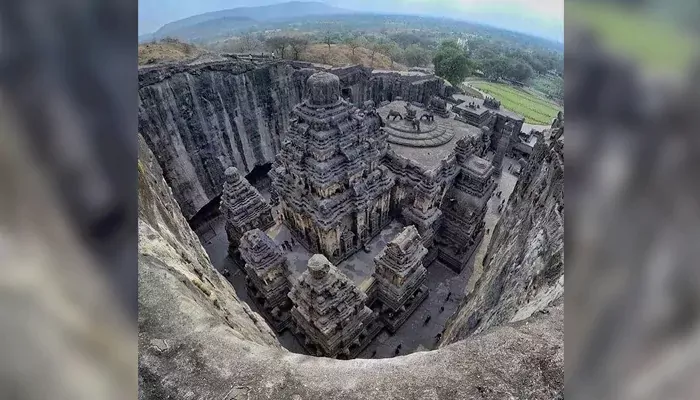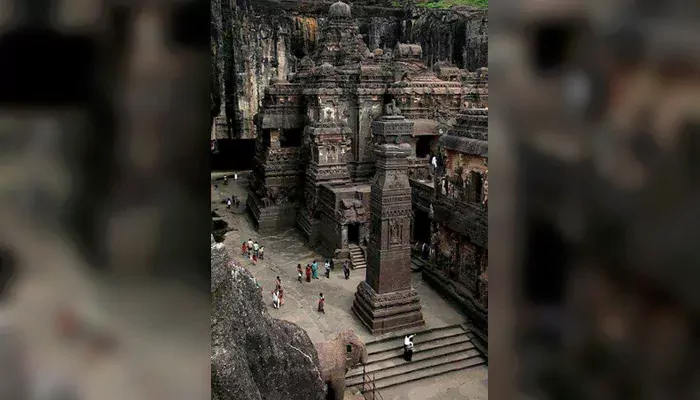
Is it ancient human brilliance or something beyond our world? Let's try to understand.
When you stand in front of the Kailasa Temple in Ellora, it's hard not to be awestruck. The structure was excavated top-down and was carved from a single rock, with intricate pillars, massive courtyards, and detailed sculptures among other things. And the wild part is that it was done over 1,200 years ago, supposedly without modern tools or technology. Well, that’s where the mystery begins. How did ancient builders manage something so precise? And why don’t we find any tools, blueprints, or even ruins nearby that explain the process? And if humans didn’t have the tech, could something (or someone) else have helped? Some believe it’s the work of brilliant ancient engineers, while others suggest a more out-of-this-world theory: aliens (and before you make assumptions, I’m not a fan of Ranveer Allahabadia). Yes, the same theory that pops up around Egypt’s pyramids and Peru’s Nazca Lines has found its way to Ellora.
So, in this story, we’ll dive into both science and speculation, examining history, engineering, legends, and theories. Let’s try to decode one of India’s most puzzling wonders.
Among the 34 rock-cut caves that make up the UNESCO-listed Ellora complex, Cave 16, Kailasa, is undoubtedly the crown jewel. Commissioned during the reign of the Rashtrakuta king Krishna I around 756-773 CE, the temple is dedicated to Lord Shiva and modeled after his mythical Himalayan abode, Mount Kailash. It stands not as a structure assembled, but as a form revealed, dug top-down from a single outcrop of basalt.
Measured, it is vast: 276 feet long, 154 feet wide, and rising to a height of over 100 feet. Carved directly from the mountainside, with galleries, bridges, pillared halls, and elaborate narrative friezes, Kailasa contains within its form a whole architectural cosmos.
Estimates suggest that over 400,000 tons of rock were removed in the process, which would have taken thousands of workers well over a decade, perhaps two.
Thread of the world's strangest architecture that most people haven't heard of....🧵
— Lost Temples™ (@LostTemple7) July 21, 2025
1. The Kailasa Temple in Ellora, that can never be built once again on Earth! pic.twitter.com/G7STjVUXLm
(Credit: Lost Temples)
The Rashtrakutas, who ruled much of the Indian subcontinent between the 8th and 10th centuries, were not strangers to monumental ambition. From the sculpted caves of Elephanta to the intricate temples of the Deccan, they oversaw projects that celebrated both divine devotion and imperial power.
What sets Kailasa apart is not only scale but also strategy. Its vertical excavation defied the norm. Rather than build upward, as with traditional stone architecture, artisans began at the cliff’s summit and carved downward, shaping columns and facades as they went, ensuring no collapse as they hollowed out chambers and courtyards.
So, how was this possible? The tools were simple (including iron chisels, hammers, and wedges), but the technique was anything but. The basalt was often soaked in water to soften its grip, and teams of artisans were likely drawn from across the subcontinent, including skilled labor from rival dynasties.
A study by archaeologist M.K. Dhavalikar calculated that a team of 250 workers, each removing roughly four cubic feet of rock per day, could complete rough excavation in about five-and-a-half years, though sculpting and detailing would have added many more. Others suggest between 7,000 to 10,000 workers were involved over two decades.
Still, puzzles remain, as no detailed records of its construction have surfaced. There are no scaffolding remnants either. And obviously, there are no massive piles of displaced rock. Some of that may be explained: debris likely eroded or was repurposed. The absence of detailed documentation reflects the oral traditions of the time rather than a cover-up.
The mainstream explanation makes no sense.
— Forgotten History (@4biddntruth) June 3, 2025
We’re told the Kailasa Temple in Ellora was carved, not built, but carved top-down out of a single rock using nothing but chisels and hammers.
And somehow… that’s supposed to explain everything?
Over 200,000 tons of rock were… pic.twitter.com/3hFGXDQ3Z9
(Credit: Forgotten History)
For many, though, these gaps have proved fertile ground for speculation.
The notion that the Kailasa Temple was built by (or with the help of) extraterrestrials is not rooted in ancient Indian texts, but in modern Western fringe theories. In 1968, Swiss writer Erich von Däniken published 'Chariots of the Gods?', arguing that many ancient marvels were too sophisticated to be human-made. Kailasa, with its scale, symmetry, and unexplained techniques, soon joined the pantheon alongside Egypt’s pyramids and Peru’s Nazca Lines.
The theory gained traction through shows like Ancient Aliens, which point to the temple’s “sudden” complexity, apparent lack of tool marks, and mythological references like Ravana’s Pushpak Vimana (a flying chariot from the Ramayana) as “evidence” of advanced, non-human intervention.
But scrutiny dismantles the argument. For one, tool marks do exist, visible under close inspection and documented by the Archaeological Survey of India. No anomalous materials, strange alloys, or inscriptions suggest anything but a terrestrial effort. More importantly, Kailasa doesn’t appear from a vacuum. It builds on centuries of rock-cut architecture, from Ajanta’s Buddhist caves to Badami’s Chalukyan shrines.
What the alien hypothesis misses is history itself. Human civilizations, especially in India, evolved technical mastery gradually. There are no shortcuts to what Kailasa represents.
Though formal records are scant, local legend fills the void. One Marathi tale, passed down through oral tradition, speaks of a queen from Ellichpur who vowed to fast until a temple to Shiva was raised - an act of devotion after her husband recovered from a grave illness. To fulfill her wish swiftly, the architect Kokasa began carving from the top, promising to reveal the shikhara within a week. The temple, they say, was named Manikeshwar after her.
It’s a romantic tale, and like most legends, its truth lies in spirit, not specifics. Stories like these humanize the extraordinary, grounding impossible feats in personal acts of faith. They aren’t meant to explain the architecture, as they exist simply to make sense of its emotional weight.
The 8th century rock cut Shri Kailasa Temple Ellora , Maharashtra. 🪨🛕 🇮🇳 pic.twitter.com/mpYF80dDVc
— India Aesthetica (@IndiaAesthetica) June 1, 2025
(Credit: India Aesthetica)
And that emotional weight remains. Kailasa is a living site of worship and a pilgrimage destination, especially during Maha Shivaratri. Its myths coexist with its carvings, shaping how it is experienced, and not just understood.
Among archaeologists and art historians, there is no serious debate: the Kailasa Temple is the peak of human skill. As Dr. Dhavalikar notes in 'Ellora: Monumental Legacy', the temple reflects a “natural progression” of Indian rock-cut traditions, drawing inspiration from Pallava and Chalukya temples of the south.
The Virupaksha Temple at Pattadakal, for instance (built just a decade earlier), shares a similar architectural vocabulary. The mandapa, the friezes, even the modest height of the gopuram suggest continuity, not rupture.
UNESCO, in designating Ellora a World Heritage Site in 1983, praised Kailasa as the zenith of Indian rock-cut engineering. Studies by the National Institute of Advanced Studies in Bengaluru have further modeled how teams with basic tools and strong planning could achieve such precision.

Even the temple’s drainage system, revealed in a 2019 survey by the ASI, displays practical foresight. Channels carved into the rock manage monsoon runoff, preserving the structure. As Dr. Shreekant Jadhav puts it succinctly: “It’s extraordinary, but not inexplicable.”
We often look to the stars when what we see on Earth feels too majestic. However, the temptation to invoke aliens says more about us than about the monuments themselves. It reflects how little we trust the depth of our own past.
The Kailasa Temple does not need an alien to be awe-inspiring. What it requires is serious attention to what human beings are capable of when driven by faith and ambition. In its carvings, we see stories etched in stone. In its scale, we see the measure of human perseverance. And in its shadow, we glimpse a civilization reaching, with nothing but hammer and hand, toward the divine.